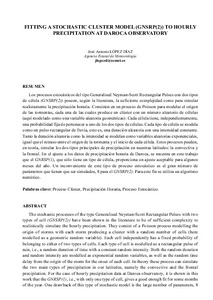Por favor, use este identificador para citar o enlazar este ítem:
http://hdl.handle.net/20.500.11765/8312
Fitting a stochastic cluster model (GNSRP(29)) to hourly precipitation at Daroca Observatory
| Título : | Fitting a stochastic cluster model (GNSRP(29)) to hourly precipitation at Daroca Observatory |
| Autor : | López Díaz, José Antonio

|
| Palabras clave : | Proceso clúster; Precipitación horaria; Proceso estocástico; Hourly precipitation; Cluster process; Stochastic process |
| Fecha de publicación : | 2012 |
| Editor: | Asociación Española de Climatología |
| Citación : | Rodríguez Puebla, Concepción; Ceballos Barbancho, Antonio; González Reviriego, Nube; Morán Tejeda, Enrique; Hernández Encinas, Ascensión (eds.). Cambio climático. Extremos e impactos. Madrid: Asociación Española de Climatología, 2012, p. 479-488 |
| Resumen : | [ES]Los procesos estocásticos del tipo Generalised Neyman-Scott Rectangular Pulses con dos tipos
de célula (GNSRP(2)) poseen, según la literatura, la suficiente complejidad como para simular
realistamente la precipitación horaria. Consisten en un proceso de Poisson para modelar el origen
de las tormentas, cada una de las cuales produce un clúster con un número aleatorio de células
(aquí modelado como una variable aleatoria geométricas). Cada célula tiene, independientemente,
una probabilidad fija de pertenecer a uno de los dos tipos de células. Cada tipo de célula se modela
como un pulso rectangular de lluvia, esto es, una duración aleatoria con una intensidad constante. [EN]The stochastic processes of the type Generalised Neyman-Scott Rectangular Pulses with two types of cell (GNSRP(2)) have been shown in the literature to be of sufficient complexity to realistically simulate the hourly precipitation. They consist of a Poisson process modelling the origin of storms with each storm producing a cluster with a random number of cells (here modelled as a geometric random variable). Each cell independently has a fixed probability of belonging to either of two types of cells. Each type of cell is modelled as a rectangular pulse of rain, i.e., a random duration of time with a constant random intensity. Both the random duration and random intensity are modelled as exponential random variables, as well as the random time delay from the origin of the storm for the onset of each cell. In theory these process can simulate the two main types of precipitation in our latitudes, namely the convective and the frontal precipitation. |
| Descripción : | Ponencia presentada en: VIII Congreso de la Asociación Española de Climatología celebrado en Salamanca entre el 25 y el 28 de septiembre de 2012. |
| URI : | http://hdl.handle.net/20.500.11765/8312 |
| ISBN : | 978-84-695-4331-3 |
| Colecciones: | (2012, Salamanca). VIII Congreso AEC |
Ficheros en este ítem:
| Fichero | Descripción | Tamaño | Formato | ||
|---|---|---|---|---|---|
| 0046_VIII-2012-JA_LOP... | 1,93 MB | Adobe PDF |  Visualizar/Abrir |
Los ítems de Arcimis están protegidos por una Licencia Creative Commons, salvo que se indique lo contrario.





